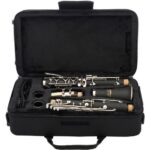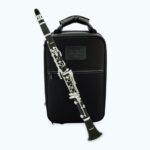Many people confuse the oboe with the clarinet. However, if you only look at some of their parts, you will see that the two are different. So, oboe vs clarinet, what are their differences?
The most obvious difference between the oboe and the clarinet is that the former has two reeds, but the latter has only one. Another very noticeable difference is the instruments’ bores. The oboe has a rounded bore, while the clarinet has a cylindrical bore.
Another big difference between the oboe and the clarinet is how a beginner learns them or how a player can master them. The clarinet is much easier to learn than the oboe. Part of that is probably because it is just hard to produce the right sound in an oboe.
Read on to learn more about the oboe vs clarinet issue, their differences, their histories, and some of the things that will get you more interested in them.
Also, we hope you find the links here useful. We may get a commission if you purchase something through a link on this page, so thank you!
Also, for an excellent clarinet, take a look at the Jean Paul USA CL-300 Student Clarinet on Amazon for its price and great reviews:
Click here to see it on Amazon.
For an excellent oboe, take a look at the Rochix Beginner Student Level Oboe on Amazon for its price and great reviews:
Click here to see it on Amazon.
Oboe vs Clarinet

Though many people confuse the oboe with the clarinet, it is not really difficult to see their differences if you look closely at them. First, if you look at their reeds, you will see that the clarinet has only one reed while the oboe has two.
And then, if you look at their bores, you will notice that the oboe has a rounded bore while the clarinet has a cylindrical bore. But there’s more. Another pronounced difference is their bells. The bell of the clarinet is flared while the bell of the oboe is rounded.
From afar, you may think they look the same. But in close range, you will really see their differences easily. So, while they appear the same, it is actually how their parts look that makes them different from each other.
But it is not only in their appearances that the oboe and the clarinet are different. The difficulty in learning and mastering them is also different. Many instrumentalists say that the oboe is more difficult to learn and master than the clarinet.
Because the clarinet is easy to learn, it became more interesting to music creators. That was said because there was more music written for it than the oboe. More people can play the clarinet because it’s easier to learn and play.
It can’t be denied that there are many differences between the oboe and the clarinet. But they are also similar in some ways. These differences and similarities are what I will discuss with you in this article.
Similarities Between the Oboe and the Clarinet
Let us first tackle the similarities between these two instruments to appreciate their differences better, which we will discuss after this. Here is a table that will explain their similarities:
| Oboe | Clarinet | |
| Type of Instrument | Part of the woodwind family of instruments | It also belongs to the woodwind family of instruments |
| Average Size | Length is about 26 inches | Length is around 27.5 inches |
| Clef | Treble clef | Treble clef |
| Usage | Used in classical music, concert bands, orchestras, solos, movie and film scores | Also used in classical music, concert bands, orchestras, solos, movies, and film scores |
Differences Between the Oboe and the Clarinet

To help you get an overview of how different an oboe is to a clarinet, here is a table that shows each of their differences in every aspect of the instruments:
| Oboe | Clarinet | |
| Instrument Overview | It uses two reeds, has a bore that is conical in shape | It uses only one reed, has a cylindrical bore or reverse cylindrical in shape. |
| Usage | Used in romantic and baroque music, Celtic, traditional, chamber ensembles | Used in chamber and folk music, marching bands, country and pop, rock, Cuban, Latin and Jazz, and choro |
| Note Range | It is more restricted in its note range | Known to have the widest note range in the woodwind family of instruments |
| Sound | Sound is bright and also amplified and penetrative due to its conical bore | Sound is generally more round, mellow and dark. Timber can be different from player to player |
| Playing Style | Baroque and classical | Romantic, folk, classical, and jazz |
| Instrument Types | Baroque oboe, Oboe D’Amore, Bass oboe, Piccolo oboe, and English Horn (Cor Anglais) | Contrabass clarinet, contra alto clarinet, Bass clarinet, Alto clarinet, Basset horn, Basset clarinet, Soprano clarinet, Sopranino clarinet, and Piccolo clarinet |
| Ease of Learning | More difficult to learn requires continuous practice and a capable oboe instructor to master | Finger basic can be easily learned in just a matter of months, requires constant practice to produce rich and dark timber and master the airflow. |
| Origin | The origin of the oboe is uncertain, but it surfaced in French courts during the mid-17th century. | The predecessors of the clarinet are hornpipes such as the alboka, the albogue, and the double clarinet. Improvements were made by Hyacinthe Klose that gave us the modern clarinet. |
| Price | $390 to $10,000 | $125 to $9,000 |
Again, oboe vs clarinet-what is the difference between them? The most distinct difference between the two instruments is the number of reeds; the oboe has more reeds than the clarinet. Apart from this, the oboe has a rounded bore while the clarinet has a cylindrical bore.
Detailed Descriptions of the Differences Between the Oboe and Clarinet
To fully understand their differences, you need to see the details. So, here are the detailed descriptions of the differences between the clarinet and the oboe:
Oboe vs Clarinet Usage Differences
Click here to see this Glory Oboe C Key Cupronickel Plated Silver on Amazon.
Musicians in all music genres generally accept the clarinet more than the oboe. This instrument can be found in most orchestral groups. Musicians use it in the following:
- Concert bands,
- Rock and pop groups,
- Jazz ensembles, and
- Orchestras that play classical music.
On the other hand, the oboe is mostly used in Western classical music, although certain exceptions exist. It is also used in the following:
- Film scores,
- Rock,
- Pop,
- Jazz music, and
- Traditional folk music.
Oboe vs Clarinet Sound Differences
The oboe has a distinct and penetrative timber. This is the result of its conical bore. It makes this instrument strongly audible over the other instruments in a large ensemble. The reed also contributes to the loudness of the instrument. It delivers a certain signal to the quality of the sound that it produces. The sound of an oboe is generally bright treble.
Click here to see this Rochix Oboe Professional Performance Level on Amazon.
The clarinet also has a distinct timbre which is due to its cylindrical bore. This timber varies with the tone ‘height,’ which can be attributed to the altissimo (highest note register), the clarion (middle register), or the chalumeau (lowest register). The sound coming from a clarinet will also differ from player to player and the music being played.
Additionally, clarinets have the widest pitch ranges in the family of woodwind instruments. The sound of a clarinet is generally mellow and not bright.
Differences in the Clarinet and Oboe Keys
The keys of a clarinet are straightforward and have a very rudimentary design. A beginning player can master the virtuoso technique on a clarinet in a relatively short time. It is said that a person who can tie their shoes well already has a good technique that they can adapt to the clarinet.
Click here to see this Mendini by Cecillo Bb Clarinet w/Case on Amazon.
The oboe, on the other hand, has an elegant and intricate key work. This instrument has grace and beauty that professional oboists enjoy. It takes a lifetime to develop a good playing technique on this instrument.
A player must perform cross-fingering and press its keys at lightning speeds to play it professionally. Constant practice is required before an oboist can play this instrument decently.
Differences in Oboe and Clarinet Bells
The oboe has a round and compact bell. It produces and projects the sounds from its bell, which has a not so noticeable flare. The clarinet, on the other hand, has a bell that is obnoxiously flared.
It seems that the clarinet is trying to mimic the appearance of the trumpet. Musicians are still in the dark why the clarinet is designed with a flare like this when it does not compensate for the sounds it produces.
Ease of Learning the Oboe and Clarinet
Learning to play the clarinet is much easier than learning to play the oboe. Still, you have to spend a decent amount of time before producing good sounds from the clarinet. If you are a beginner and want to play the clarinet decently, you have to spend around 4 to 6 months learning to play the instrument.
Click here to see this Mendini by Cecilio B Flat Beginner Clarinet with 2 Barrels on Amazon.
It is different from the oboe. It isn’t easy to produce the right sound from an oboe right off the bat if you are starting to learn it. That is why having a good oboe, and a very competent oboe teacher will go a long way in learning and mastering this instrument. If you want to master it, you really need to be regular and consistent in scheduling your practice.
General Usage of the Oboe and Clarinet
The different sounds these two instruments produce define their best usage in music playing and creation. Generally, the sound produced by the clarinet is more on the mellow side, while the sound of the oboe is on the brighter side.
So, the clarinet can blend well with the other musical instruments in an orchestra. At the same time, the oboe has no difficulty standing out from among the many instruments in the same orchestra.
That is why the oboe is the popular choice for solo sections in an orchestra piece. With its mellow tone, the clarinet is usually given a general role of providing additional texture to the music score.
Differences in Price Between the Clarinet and Oboe

The oboe generally is pricier than the clarinet. A clarinet intended for a student usually commands a price starting at $400. However, as the student raises their ability to play the clarinet, they will need a corresponding clarinet that can cost around $700 or even more. Professional players usually spend about $1,000 to buy their clarinets.
Meanwhile, an oboe for a student is priced much higher than a student clarinet. Usually, the beginner oboe is priced at around $1,800. However, as the student’s ability to play the oboe improve, they will need a corresponding oboe. They will have to shell out from $6,000 to $8,000 for a good quality oboe.
Different Origins of the Oboe and Clarinet
When it comes to their origins, the beginning of the clarinet is a lot clearer than the start of the oboe. The origin of the clarinet is attributed to an instrument maker in Nuremberg whose name was Johann Christian Denner. Apparently, he developed the progenitor of the clarinet in 1700.
That first clarinet was longer than today’s clarinets. It also had a wider bore, 2 keys, 8 holes, and a bell. Later, Louis Buffet, an instrument maker, received a suggestion from a certain Hyacinthe Klose that the clarinet could be produced using the Boehm system.
That suggestion resulted in the development of a clarinet with 17 keys and 6 rings that can control the 24 holes of the instrument. This clarinet is essentially the design of modern clarinets used in orchestras and ensembles today.
Meanwhile, it is believed that the oboe originated from antiquity. They say it was called the zurna, which appeared at overlapping time periods with the Shawn, a loud double-reed instrument. The Shawn is believed to be the ancestor of the oboe.
This instrument appeared in the 13th century. It was the most important loud instrument at the end of the Middle Ages. The Shawn was used by ensembles and dance bands in court and municipal ceremonies at that time.
Then the real oboe was probably developed in King Louis XIV’s court in 1657. It was called then hautbois. But most of the development of the modern oboe occurred in the 1800s. Its final form and shape were created by George Gillet and France Loree in 1906. Open rings were now being used instead of finger plates.
Conclusion: Clarinet vs Oboe
There are many obvious differences between the oboe and the clarinet. The numbers of their reeds are different. An Oboe has two reeds, while the clarinet has only one. Their bores are also very different. The clarinet’s bore is cylindrical, while that of the oboe is rounded.
Their basic voice registries are different as well. The clarinet’s voice is on the mellow side, while the oboe’s voice is brighter. So, the clarinet can blend well with other instruments in the ensemble, while the oboe’s sound can be distinguished quite well from the sounds of the other instruments in a music piece.
Related reading:








![Easy Clarinet Songs [Top 10 Easiest] Easy Clarinet Songs](https://musicalinstrumentpro.com/wp-content/uploads/2021/10/Easy-Clarinet-Songs-150x150.jpg)







